50TH ANNUAL CONFERENCE, Amman, Jordan, 11-15 April 2011WP No. 89Aerodrome – Study Runway Status LightsPresented by TOC |
Summary
Runway Status Lights (RWSL) is a set of new technologies emerging in the United States to reduce runway incursions. RWSL was designed as a safety net that uses red lights to warn pilots and drivers of a runway conflict. The FAA is deploying RWSL at major US airports and other ANSPs are planning implementations as well. This paper describes system operation and discusses known and potential issues with its use.
This paper proposes policy in support of RWSL technologies provided certain criteria are met. It also proposes policy to address the use – and misuse – of RWSL display information.
Introduction
1.1 Most runway incursions are the result of a pilot deviation.
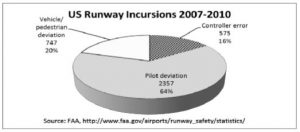
Figure 1: US Runway Incursions
Eurocontrol reported similar data at a 2009 workshop:
- 63% of all incursions – Aircraft enters or crosses a runway without a clearance.
- 28% of all incursions – Airside vehicle driver enters or crosses a runway without a clearance.
1.2 Airports across the world continue to experience runway incursions. Charles De Gaulle in Paris has in excess of 30 per year.
1.3 Some of the worst aviation disasters in history were runway incursions. Runway incursions are not just about safety but there are financial implications as well. “One runway incursion happens daily on average worldwide, at a cost to the industry of about $100 million a year,” said TK Kallenbach, Honeywell Vice President of Product Management.
1.4 While incursions are down worldwide, lower traffic levels have been a factor. New technologies will be needed to improve safety when traffic levels rise. The Runway Status Lights (RWSL) technology aims to reduce runway incursions and the impact of runway incursions by providing an additional level of defense. RWSL gives pilots and vehicle drivers a direct, heads-up warning of a potential runway incursion or collision. RWSL operates automatically to correct for both controller and pilot/driver errors.
1.5 RWSL is planned and funded for deployment at 22 US airports (see Appendix A). Eurocontrol has done extensive work building safety, human factors, simulation, cost benefit and requirements cases and put these out for comment in December 2010.
1.6 An online survey of IFATCA MAs indicated there is little knowledge or use of RWSL outside the US but a lot of interest. Improving runway safety is a high priority within IFATCA. The survey indicated that just Switzerland, France and the US have plans to test or deploy RWSL in the next two years.
1.7 The RWSL physical architecture consists almost entirely of COTS/NDI (Commercial off-the-shelf / non-development item) hardware.
1.8 A related system called Final Approach Runway Occupancy Signal (FAROS) alerts pilots of arriving aircraft of the presence of another aircraft on the arrival runway.
Discussion
2.1 General
2.1.1 RWSL is a set of technologies that draws real-time data from fused, multi-sensor surveillance including multilateration, ADS-B, surface radar and others. Based on this data, RWSL uses lights on the airport surface to indicate directly to pilots and vehicle operators if it is unsafe to proceed. The RWSL systems include warnings at several phases of aircraft operation, including entering a runway, initiating takeoff, and taxiing on a runway.
2.1.2 The following are requirements and protocols of RWSL systems as used in the United States:
- RWSL must not interfere with normal safe operations.
- RWSL must operate automatically with no controller action required.
- Lights are timed to allow for ATC use of anticipated separation. For example, red lights at a runway crossing will actually dim a few seconds before the departing aircraft passes the intersection, since the crossing aircraft is not physically able to enter the runway in that time.
- Clearance will be provided by ATC as always.
- When lights are on, pilot must stop.
- When lights are off, pilot proceeds only with a clearance.
- The lights apply to vehicles as well.
- Light intensity is automatically increased in low visibility conditions.
2.1.3 A typical installation of RWSL costs US$ 1 million, provided ASDE-X and ASR data are readily available.
2.1.4 A graphic of the RWSL environment is shown below:

Figure 2: RWSL Schematic (from https://www.rwsl.net)
RWSL Systems Description
2.2 Runway Entrance Lights (RELs)
2.2.1 RELs warn pilots when it is unsafe to taxi onto a runway. The following are characteristics of RELs as deployed by FAA:
- Activate when a high-speed (more than 30 knots) target is on the runway. RELs are unlike the other RWSL systems as they light up regardless of whether there is potential traffic.
- Turn on and off progressively as the aircraft travels down the runway.
- Align with taxiway centerline.
- Point towards the taxiing aircraft.
- Line of single red lights directed toward taxiway hold line.
- Different from “Stop Bars” which are not illuminated based on runway activity.

Figure 3: Runway Entrance Lights
2.2.2 When RELs illuminate, pilots taxiing should:
- Remain clear of the runway.
- When cleared to “cross the runway”, “position and hold”, or “immediate takeoff” (issued to an aircraft still on the taxiway) –
- Stop the aircraft, notify ATC the aircraft is stopped with red lights and wait for further clearance.
- If the aircraft crosses the hold line –
- Stop the airplane and notify ATC the aircraft is stopped across the hold line because of red lights.
2.3 Takeoff Hold Lights (THLs)
2.3.1 THLs are warnings provided to pilots in takeoff position. The following are characteristics of THLs as deployed by FAA:
- Activate when is unsafe to depart from a runway.
- Activation requires the presence of a departing aircraft on the runway and another aircraft or vehicle crossing the holding point at a runway entrance ahead of the departure.
- Provide a direct indication to pilots when it is unsafe.
- Single- or double-line of red lights on the centerline of the runway, directed towards the takeoff end of the runway.
- Visible from takeoff hold position (and final approach).
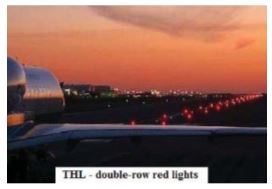
Figure 4: Takeoff Hold Lights
2.3.2 When THLs illuminate, pilots in takeoff position should:
- If lined up on the runway –
- Remain in position for takeoff.
- If takeoff roll has begun –
- Stop the airplane and notify ATC they are stopped because of red lights.
- If aborting the takeoff is impractical for safety reasons –
- Proceed according to best judgment (understanding the THLs indicate the runway is unsafe for departure) and contact ATC at the earliest opportunity.
2.3.3 A runway incursion in the Canary Islands in 1977 caused the greatest loss of life of any accident in aviation history. THLs would likely prevent a similar event.
2.3.4 One example of a THL save was May 2008 at DFW. AAL379 was cleared for departure on 36R and 20 seconds later MES3675 crossed 36R during AAL379’s takeoff roll. THLs illuminated and AAL379 aborted.

Figure 5: RWSL Monitor Display Depicting THL Save
The pilot was quoted:
“After cleared for take-off, we began to roll and I noticed the RWSL lights turn red. I looked down the runway and saw an aircraft crossing the runway left to right (Mesaba regional jet) and aborted the takeoff (max speed below 80 knots). The RWSL worked awesome. I noticed that before I saw the intruding regional jet.”
2.4 Runway Intersection Lights (RILs)
2.4.1 RILs are a warning to pilots approaching an intersection of two runways. The following are requirements and properties of RILs as deployed by FAA:
- Activate when it is unsafe to cross an intersection while on the runway.
- Activation requires the presence of an aircraft on the runway and another aircraft or vehicle on the intersecting runway.
- Single- or double-line of red lights on the centerline of the runway, directed towards the takeoff end of the runway.
- Illuminate when it is unsafe to cross intersection.
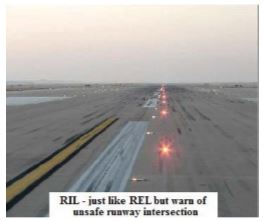
Figure 6: Runway Intersection Lights
2.4.2 When RILs illuminate, pilots taxiing towards the intersections should:
- Remain clear of the intersection.
- When cleared to cross the intersection –
- Stop the aircraft, notify ATC the aircraft is stopped with red lights and wait for further clearance.
Operational Issues
2.5 Pilot View of RWSL
2.5.1 A March 2007 White Paper by the US Air Line Pilots Association on Runway Incursions strongly endorsed the deployment of RWSL systems at all large hub airports.
2.5.2 IFALPA fully supports the establishment of a global standard for Runway Status Lights. The following is proposed policy from their Aerodrome and Ground Equipment Committee meeting in November 2010:
Runway Status Lights are warning systems and shall require minimal recognition and reaction times from flight crews and shall function in the same way and provide identical displays. These safety critical systems shall be designed to provide consistent, universally recognized displays.
2.5.3 The following is current policy of the European Cockpit Association (ECA):
- ECA strongly believes that RWSL should only inform about a danger and therefore thinks that the use of any other colour than red should be avoided, as this could lead to confusion.
- Before implementing RWSL, training for pilots is recommended. In addition, correct information shall be given to the users, in order to avoid any confusion, through the NOTAMs, the airport charts and briefing leaflets, among others.
- RWSL shall not question the authority of air traffic controllers and pilots, but should be seen as additional guidance.
- ECA encourages designers to work together towards a system that is recognised and agreed upon worldwide. Only through harmonisation and involvement of all stakeholders can the system fulfil its final aim, i.e. the improvement of aviation safety.
- The extinguishing of the lights shall not be perceived as a clearance to proceed, which can only be given by the air traffic controller.
This last policy is in line with existing IFATCA policy on Stop Bars [ADME 2.11]:
| Stop bars shall be switched on to indicate that all traffic shall stop. Stop bars shall be switched off to indicate that traffic may proceed when authorized by the aerodrome control tower. |
2.6 Controller Experiences with RWSL
2.6.1 TOC conducted an online survey of 28 US controllers who have worked traffic with RWSL operational at the test sites. The following are results:
- 86% said RWSL will improve runway safety, with the following breakdown:
- THLs – 75%
- RELs – 57%
- RILs – 46%
- Almost half thought RWSL would reduce runway incursions by 25%.
- The issues identified included the following:
- False indications – 64%
- Pilot training – 32%
- Confusion with other lights – 32%
- Other – 21%
- 72% felt they had not received adequate training.
- Some notable comments included:
- RWSLs or even single lights sometimes get stuck in the on position.
- Pilots sometimes think they are cleared to cross when the lights dim.
- There is no indication of system status in the tower.
- In some facilities, there is no indication of an RWSL activation.
- There are too many calls from pilots questioning the lights.
2.6.2 NATCA’s two top Reps on RWSL work at KDFW and KLAX and have considerable experience working with it. They are concerned with the following:
- Pilots asking when the lights will turn green.
- Pilots crossing runway without clearance when lights go off.
- Reconciling RWSL and stop bars with each other.
- Standardization of RWSL brightness.
- Frequent outages and lack of system status indications to controller.
- Issues involving vehicles approaching a runway from the grass.
- Experience at KBOS indicates that snow and ice are not an issue.
- Anticipated issues with Land-and-Hold-Short seem to have been resolved.
2.7 Existing IFATCA Policy on Safety Nets
2.7.1 Regarding ACAS, IFATCA policy is [AAS 1.1]:
| ACAS should only be considered as a ‘safety net’. |
RWSL is a very similar system as it operates independently of both controller and pilot, and provides visible (but not audible, like ACAS) indication that a conflict could be imminent. It is therefore appropriate to model RWSL policy after ACAS policy.
2.7.2 Regarding safety nets, IFATCA Policy is [ATS 3.18]:
| A safety net is an airborne and/or ground based function, the sole purpose of which is to alert the pilot or controller of the imminence of collision of aircraft, aircraft and terrain/obstacle, as well as penetration of dangerous airspace. |
RWSL fits this definition of a safety net, although perhaps vehicles should have been included in this policy.
2.7.3 Regarding Short Term Conflict Alert (STCA), an automated system that predicts reduction of aircraft spacing to below specified parameters, IFATCA Policy is [ATS 3.21]:
| Ground based safety nets, like STCA, can enhance overall safety in the automated ATC systems. Therefore each automated ATC radar system should be provided with a groundbased safety net system such as STCA, as a last resort, that only should be used to advise the controller of potential losses of separation.
Controllers shall be involved during the design and development phase with proper introduction and training as necessary when implementing STCA systems. It is important that, for each individual ATC radar unit, parameters and nuisance filters in STCA systems are developed and tested that are suitable for the area involved and adjusted to the procedures, airspace layout, separation standards, radar source, traffic mix, etc. The systems’ logic and parameters should be flexible. In ATC areas where STCA will be installed, studies and real time simulations shall be carried out to ensure that possible conflicting warnings with TCAS can be kept to a minimum. An STCA function should not be considered when developing a safety case, unless it can be demonstrated that the functionality is used in a separation assurance mode of operation. |
2.7.4 RWSL is different from STCA because it provides alerts directly to the pilot. However, these policies could be appropriate for RWSL as well.
Nuisance filters or false alerts are clearly a problem with RWSL and could easily impact the flow of traffic on the airport surface and nearby. Any aircraft aborting takeoff due to a false alert suddenly poses a dilemma for the controller, who must now react to this development and mentally rearrange the traffic flow without hesitation. Controllers need to understand the logic and parameters so as to be able to anticipate potential false indications.
Just as potential conflicts with TCAS must be minimized, studies and real time simulation of potential conflicts with other lighting systems would be highly desirable, as suggested by the following.
2.8 Interaction with Other Lighting Systems
2.8.1 There are numerous other lighting systems in use at airports around the world. The potential for confusing pilots is clearly present with a number of these.
2.8.2 Displaced threshold lights could be confused with THLs. These lights are also red and built into the runway. At night in an unfamiliar airport, a pilot could be confused.
2.8.3 Stop bars could also present indications that might confuse pilots. While the stop bars may indicate it’s ok to proceed, the RELs might indicate otherwise. Of course, this is the intention as the RELs are a last resort, designed to be independent of other indicators. It’s important to note that regardless of the lights, a clearance is required to enter the runway.
2.8.4 Approach lighting, such as ALSF-2 and MALSR, could have a “Christmas tree” effect and disorient pilots under varying conditions simply because there are so many lights. The FAA is conducting simulations of varying configurations.
2.8.5 Runway end lights show the pilot when the aircraft is approaching the end of the runway. These lights are alternating red and white starting 900 meters from the runway end, and then red only for the last 300 meters. Like THLs and RILs, these are red lights down the center of the runway. To avoid confusion, ICAO is considering a regulation to change the red lights to yellow.
2.9 System errors
2.9.1 If the equipment is not operating adequately, “kill switches” are available to turn off RWSL. Neither KLAX nor KDFW updates the ATIS to reflect the status of RWSL since these systems run in the background and clearances are still required for runway movement, departure and landing.
2.9.2 Controllers at KDFW and KLAX would prefer a single kill switch for RWSL rather than multiple switches. The potential for confusion would be increased with multiple switches controlling multiple components of the system.
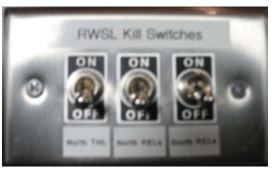
Figure 7: Kill Switches
2.9.3 Access to these switches could be an issue. At a 24-hour facility in which a single controller could be staffing the midnight shift, every controller needs to be familiar with and have direct access to these switches.
2.10 Global Consistency
2.10.1 If RWSL installations are not consistent in design at all facilities, the potential for errors would likely increase.
2.10.2 Stop bars are a similar technology. From the conclusions section of IFATCA Punta Cana WP 82:
“Stop bars are not always being used in a manner consistent with ICAO Standards and Recommended Practices for never crossing an illuminated stop bar. This inconsistent use undermines the integrity of stop bars as a safety net.”
The lack of consistency in the use of Stop Bars should be a lesson for RWSL developers.
2.10.3 RWSL is still a developing technology that has only deployed in a handful of facilities. Right now, plans are hatching to build new RWSL systems outside the US. Strong leadership and rulemaking at the international level could help avoid the development of inconsistencies between RWSL systems of different facilities.
2.10.4 In December 2010, Eurocontrol sent out RWSL design documents to Europoean states for review. They are proposing a modified concept called “Extended Runway Status Lights (ERWSL)” that includes two operational modes. In “prevention mode”, the system provides pilots and drivers with situational awareness similar to the FAA design. In “incursion mode” the lights flash to induce immediate emergency action by pilots and drives.
The Eurocontrol concept represents a divergence of global system uniformity. This could ultimately result in inconsistencies that confuse pilots. As cited in 2.5.3, the European Cockpit Association:
“encourages designers to work together towards a system that is recognised and agreed upon worldwide”.
2.10.5 The ICAO Aerodrome Panel met in October 2010 to review a proposal to amend Annex 14, Volume 1 and include an entirely new section to regulate RWSL installation and use.7The proposal provides specific guidance on the orientation, spacing and operation of THLs and RELs. The proposal also specifies: “RELs and THLs shall be automated to the extent that the only control over each system will be to disable one or both systems.” The proposal does not address the proposed flashing capability being considered by Eurocontrol. The Panel voted to include RWSL lighting configuration in Guidance Material in the Appendix to Annex 14.
2.11 Significance of Training
2.11.1 Training of pilots is vital to the success of RWSL. If pilots do not recognize the significance of the red lights and do not respond appropriately, then the system provides no benefit. Ill-trained pilots may interpret the light signals incorrectly, and proceed when the red lights turn off despite the absence of a clearance. In this case, RWSL can contribute to degrading safety.
2.11.2 Training of controllers is also important. While the system operates automatically and almost invisibly, any activations – false or real – will likely have an impact on the airport operation and affect the controller’s decision-making. The controller’s understanding of why the lights activate is essential to the resulting decision-making process.
2.12 Charting
2.12.1 Pilots must be trained, but they must also possess charts that properly identify RWSL installations.
2.12.2 The FAA has been working with Jeppessen, NACO (US National Aeronautical Charting Office), and LIDO (Lido Lufthansa Aeronautical Services GmbH) on charting for RWSL. The International Aeronautical Charting Committee is developing their standard for all three charting sources to use. Jeppessen has published individual charts for each of the four R&D sites, KSAN, KDFW, KBOS and KLAX. Figure 8 shows an example section.
2.12.3 Charts are ideal for reminding pilots not to proceed without a clearance. The following language or something similar would likely serve that purpose: “The extinguishing of RWSL lights is not a clearance to proceed – you still need ATC clearance to move.”
2.12.4 Identification of RWSL systems also provides a means of alerting untrained pilots to the presence of something new.

Figure 8: Published RWSL Annotation
2.13 Human Machine Interface and Display of RWSL Information
2.13.1 Some installations, including KDFW and KSAN, have an RWSL monitor in the tower. The monitor display depicts surface aircraft and provides an indication when RWSL lights are activated. An example of such a display is shown here.
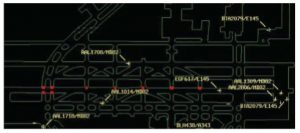
Figure 9: RWSL Monitor Display
2.13.2 There are issues with these monitors:
- Although they seem to provide a radar-like display, they do not depict aircraft with no transponder. Primary radar returns are not depicted.
- The monitors are primarily meant to show RWSL activations but controllers tend to use them like a radar display.
- The display does not always update in a timely manner.
- The display was designed to monitor the RWSL lights, not to track aircraft or vehicles.
- The displays are known to freeze up in the presence of large numbers of aircraft.
- Although a flight plan may time out, the RWSL display will not reveal this.
- The presence of yet another monitor requires additional scanning time that adds workload and creates potential liability.
2.13.3 The temptation in the tower is to use the RWSL monitor for traffic surveillance or possibly even control purposes, but given the issues noted above this is clearly a dangerous practice.
2.13.4 Use of the RWSL display monitor for obtaining information regarding the status of the RWSL lights would require careful consideration of legal responsibilities.
2.14 Final Approach Runway Occupancy Signal (FAROS)
2.14.1 FAROS is not part of RWSL but is similar because it is operated independently of the controller and serves as an automated warning to pilots of a possibly unsafe situation. FAROS indicates to pilots on final that there may be traffic on the runway.
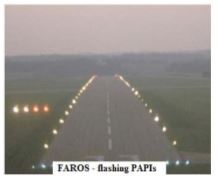
Figure 10: FAROS Lights
2.14.2 Unlike RWSL, FAROS does not use red lights in the runway or taxiway and does not require any new lighting. Instead, it takes advantage of existing runway lighting, the Precision Approach Path Indicators (PAPI), visual glideslope indicators.
2.14.3 Like RWSL, the FAROS system processes position data from multiple sources and determines whether an aircraft is on or about to enter the landing runway.
2.14.4 When the runway is occupied and the approaching aircraft has reached the arming distance (default is 1.5 nm):
- PAPIs begin flashing to pilots
- Red bar shown on RWSL display in tower
2.14.5 When the aircraft is within approximately .5 nm of landing threshold and runway is occupied:
- PAPIs begin or continue flashing to pilots
- Red bar shown on RWSL display in tower flashes red and white
- Audible advisory sounds in tower “FAROS (RWY designator)”
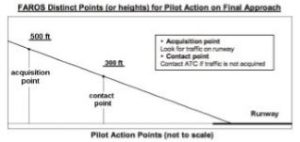
Figure 11: FAROS Action Points
2.14.6 When FAROS is activated, pilots on approach should:
- When FAROS acquisition point of approximately 500 feet AGL is reached with flashing PAPIs:
- Attempt to see traffic on runway.
- If seen, evaluate the situation then proceed with caution.
- If not seen, prepare to contact ATC at contact point.
- When FAROS contact point of approximately 300 feet AGL is reached with flashing PAPIs:
- Attempt to see traffic on runway.
- If seen, evaluate the situation then proceed with caution.
- If not seen, contact ATC to verify landing clearance and prepare for an immediate goaround.
- If ATC does not verify landing clearance promptly, go around.
- If ATC cancels the landing clearance, go around.
2.15 FAROS Testing and Experience
2.15.1 In the US controller survey mentioned in 2.6, just 7% felt FAROS had a positive impact on safety, while 25% felt it had a negative effect on safety. Note that only 54% of the responders had experiences with FAROS.
2.15.2 Regarding FAROS, the Union Representative at DFW said this:
“FAROS has been turned off now for close to a year. The alert was going off way too much, the early warnings seemed to be nothing more than a nuisance that just made the supervisor ask what was going on.”
2.15.3 As of late September 2010, FAROS has been deactivated at Long Beach (KLGB). The processing of documentation required to support its use has stalled. The FAA has put this program on hold, pending the development of a new version known as “enhanced FAROS” (eFAROS), not to be confused with the Eurocontrol concept known as E-RWSL.
Conclusions
3.1 The three core RWSL systems, Takeoff Hold Lights, Runway Entrance Lights (or Runway NoEntrance Lights), and Runway Intersection Lights clearly hold promise for reducing runway incursions and the impact of runway incursions. RWSL does not actually reduce runway incursions where no conflict is present.
3.2 International leadership in creating standards and regulating the installation and use of RWSL is critical to insuring that RWSL improves safety and does not degrade it. The latter is a real possibility if procedures at different facilities cause pilot confusion. Already, Eurocontrol has developed a concept that diverges from the FAA concept.
3.3 Training of pilots and controllers is vital to the success of RWSL.
3.4 RWSL might interact poorly with existing lighting systems, including displaced threshold lighting, end-of-runway lights, approach lighting and stop bars. These issues are largely specific to each site.
3.5 Should there be a requirement to scan an additional monitor for RWSL, controller workload and liability increase significantly, particularly because this display provides incomplete radar information.
3.6 There is a possibility that RWSL monitors are used as a traffic surveillance tool without regulation.
3.7 FAROS in its present state is an immature system which provides too many false indications.
3.8 TOC considers RWSL to be a safety net.
Recommendations
It is recommended that;
4.1 IFATCA Policy is:
IFATCA supports RWSL provided the following criteria are met:
- The system will be used as a safety net.
- It will operate automatically with no controller input required.
- The system specifications are globally harmonized under ICAO guidance.
- Potential confusion with other lighting systems is eliminated or mitigated.
- Clearance to proceed will still be required.
- All surface traffic will be required to comply with the system.
- Comprehensive training is provided to all pilots, drivers and controllers.
- False activations are kept to an absolute minimum.
and is included in the IFATCA Technical and Professional Manual.
4.2 IFATCA Policy is:
If RWSL activations are displayed to the controller, the following criteria should be met:
- The information should be efficiently incorporated into existing surveillance displays at the appropriate control positions.
- Legal responsibilities are clearly and unambiguously defined.
and is included in the IFATCA Technical and Professional Manual.
References
29 Apr 2009, Runway Status Lights Workshop, Eric Miart, Eurocontrol.
https://www.roger-wilco.net/new-tools-in-the-arsenal-to-prevent-runway-incursions-rwsl-andfaros/
https://www51.honeywell.com/honeywell/news-events/press-releasesdetails/06.15.09SmartRunway.html
Sensis Runway Status Lights Program PowerPoint, 2010.
29 Apr 2009, Runway Status Lights Workshop, Jaime Figueroa, FAA.
ICAO Aerodromes Panel, Second Meeting Working Paper AP/2-WP/10, Montreal, 12 to 15 October 2010.
Eurocontrol CND/CoE/AT/AP Summary Report, A-SMGCS Level 2 – Development and Validation of Improvement of Runway Safety New by Lighting Systems, 20 Dec 2010.


